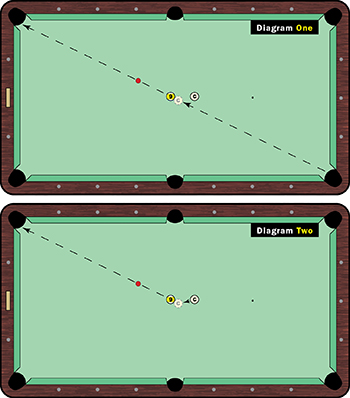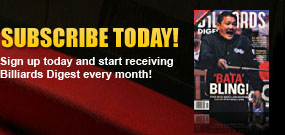Donít simply guess when faced with a blind pocket shot.
People often ask me what the most difficult shot in the game is. Of course, there are a lot of tough shots, but blind pocket shots are probably right near the top of the list. I see so many players ó even professionals ó struggle with this shot.
Mostly, the struggles come from laziness. Players often simply get down and fire away, guessing where the pocket is. Of course, that approach can work, but the chances of making the shot with any consistency really drop. Iíve seen this shot overcut and undercut, particularly when the cue ball is close to the object ball, as it is in the diagrams. At this point, the success rate is probably about 30 percent. To get that rate up to 60-70 percent, without even needing a good stroke, copy what I do. The results will help you on all blind pocket shots, but especially on those in which the cue ball and object ball are close together.
Iím not big on aiming systems, but I do have a little visual system that I use on blind pocket shots like the one in the diagrams. In this instance, I would walk around the table to the opposite corner and look at the line of the shot from one corner to the other. From that spot, I pick out a spot maybe a foot in front of the object ball (red spot). In my mind, that spot is the pocket. I donít try to visualize all the way to the actual corner pocket. I know that if I can hit that imaginary pocket, the ball will go in. It makes judging the line a lot easier.

Additionally, once I know the line, I visualize an imaginary cue ball a few feet from the object ball. Visualizing where I need to hit the object ball to send it to the red dot becomes even easier from here. Now, I see everything I need to give me the confidence that I will make the shot.
At that point, itís simply a matter of trusting what you are doing and executing the shot. On this particular shot, I would play with a touch of bottom left English to kill the cue ball. If you just play this shot with center cue ball, there is a chance youíd lose the cue ball and scratch or even double kiss the object ball. Always remember you have to control the cue ball as well.
So, remember, the key to blind pocket shots is to not be lazy. Donít simply get down on the shot and guess. Walk around the shot so you get a good look at the line of contact and the cue ball path. Pick out a short target a foot or two from the object ball and in line with the pocket. When practicing, make a little mark on the table. Determine where you need to contact the object ball to hit that mark and your percentage on blind pocket shots will go up for certain.
Use this system, particularly on close shots. I use it all the time.





